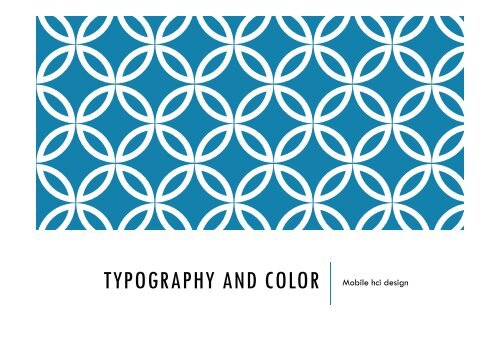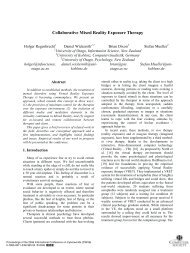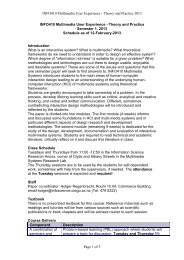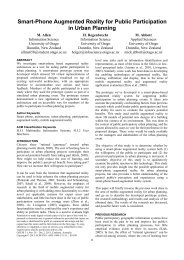David on Typography 1 - HCI
David on Typography 1 - HCI
David on Typography 1 - HCI
Create successful ePaper yourself
Turn your PDF publications into a flip-book with our unique Google optimized e-Paper software.
WHAT DO WE NEED TO CONSIDER WHEN DESIGNING FOR MOBILE? So the how do we make good looking type that is also readable. There are numerous rules out there that suggest good ways to set out your type. Lookswise, well there is no accounting for taste. Go nuts. Readability <strong>on</strong> the otherhand, you should probably listen to the rules. And like I menti<strong>on</strong>ed before, if a user cant read what youre saying then you stuffedup. From what I could gather there are 8 main features of typography that factor into anice reading block of text.
MEASURE Measure is the horiz<strong>on</strong>tal length of a line of text. The length of a line affects readability because our eyes can become fatigued fromthe l<strong>on</strong>g back and forth strokes involved in going across the pages. It also increases the likeliness of getting lost <strong>on</strong> our way down to the next line. Keeping lines to about 45-65 characters seems to be the suggested golden number.
KERNING AND TRACKING Kerning is altering the gap between two individual letters . Tracking is altering the gap between all letters in a single word or group of words. They both have a similar impact <strong>on</strong> readability . If we create too much white space between individual letters our eyes find it hard totrack and our eye movement across the pages is fragmented even more than normal . If we go the opposite way and push the letters too close together we find it hard todistinguish letters apart .
LEADING Leading is the space between two lines . A general rule of thumb is 1.25 - 1.5 times the size of the f<strong>on</strong>t. It’s a similar affect to tracking in that too close or too far and our eyes have troubletracking smoothly from line to line. Or we can find it difficult distinguishing words and letters apart.
RAGS Rags are the jagged edges of a paragraph . If a secti<strong>on</strong> of text is too jagged it becomes unappealing to look at. It makes it difficult for our eyes to go from line to line . We can get lost <strong>on</strong> our way down.
JUSTIFICATION Justificati<strong>on</strong> tidies up rags. However it can have a negative side affect . Justificati<strong>on</strong> is pr<strong>on</strong>e to creating uneven gaps between words. This again is unsightly and hard to read.
ORPHANS AND WIDOWS An orpan is a single word sitting at the bottom of a paragraph . In this case its not so much a readability issue, more an aesthetics <strong>on</strong>e. A widow is a single word from the end of a paragraph sitting in a new secti<strong>on</strong> of text. This is a readability issue because it breaks the normal flow of the sentence. It’s a single word situated away from its friends. The easiest way of dealing with rags, widows, and ophans is to manually alter yourlines of text to break at better points in the sentence or by alter tracking.
CASE The use of all uppercase is generally frowned up<strong>on</strong> for large secti<strong>on</strong>s of text but is okfor headings. The same goes for most of these tips, in the right situati<strong>on</strong> you can ignore any of theserules. Uppercase is bad because <strong>on</strong>e of the techniques we use to read is to pick up <strong>on</strong>shapes of words as opposed to actual letters . By noticing the outlines of words we quickly skip across the text deciphering what theword is as we go. By using all caps we loose this ability because all the letters are the same heightgiving the words a rectangular appearance .
SANS VS SERIF The final factor is sans vs serif. Serif f<strong>on</strong>ts have been main body text for a l<strong>on</strong>g time due to their ease of reading inprint media. The serif detailing <strong>on</strong> f<strong>on</strong>ts make it easier to tell each letter apart. However, <strong>on</strong> mobile devices where the dpi is a third of print, and viewing is <strong>on</strong> smallscreens the serif details can “bleed” together making the text hard to look at. So we go sans <strong>on</strong> mobile devices for body c<strong>on</strong>tent as the lack of serifs helps keepindividual letters apart as f<strong>on</strong>t shrinks and words are squashed together.
WHAT ABOUT SIZE? Text size factors immensly into whether our text is readable <strong>on</strong> small screens. The problem with size is that we have no c<strong>on</strong>trol over the end user. Devices make it extremely easy to alter the size of text. This means all our hard work laying type in our development envir<strong>on</strong>ment can bequickly erased. Screen sizes, resoluti<strong>on</strong>s, old peoples eyes. They are all different, and they all affectwhat the user sees <strong>on</strong> their device.
RESPONSIVE DESIGN Using websites as an example. Our typography has too look good across all devices. It has to be able to deal with bigger or smaller screens. From desktop to ph<strong>on</strong>e. Realistiaclly we have <strong>on</strong>e true opti<strong>on</strong> for dealing with this. Resp<strong>on</strong>sive design. Ultimatly, across all devices we want our typography to remain c<strong>on</strong>sistent, even if theuser alters the text size. So we need to pick a f<strong>on</strong>t that scales well and we need to use relative sizing like ems. Ems allows the screen size to change while maintaining the proper proporti<strong>on</strong>s we laidout for our text. Pixels are not a good choice for mobile design as the size can vary greatlydepending <strong>on</strong> the resoluti<strong>on</strong> of the screen.
WHAT ABOUT THE FONT ITSELF? What useful aspects of f<strong>on</strong>t should we worry about. When designing for the mobile device we want a f<strong>on</strong>t that can be seen as clearly aspossible at small sizes, <strong>on</strong>e that scales well. In general a f<strong>on</strong>t that is good <strong>on</strong> a mobile device has four characteristics. Low c<strong>on</strong>trast and simple strokes with a c<strong>on</strong>sistent weight and thickness. F<strong>on</strong>t c<strong>on</strong>trast isthe difference in thickness of the relative parts of a letter. High c<strong>on</strong>trast means a bigdifference, and this is bad because as the text shrinks the think parts can disappear. Generous x-height. The x-height is the size of lower case letters. A large x-heightmeans the n<strong>on</strong>-capitalized letters are large relative to the capitals, and so as the textshrinks theses letter maintain their form and visibility. Generous width and letter spacing. Generous punch width (space within letters). These two factors are again related tohow legible f<strong>on</strong>t remains as it shrinks in size.
WHAT FONTS DO WE HAVE ACCESS TO ON MOBILE DEVICES? In order to use a f<strong>on</strong>t the device must have it installed. Desktops have a t<strong>on</strong>ne of f<strong>on</strong>ts installed but mobiles have limited space so this isn’talways possible. From what I could find windows ph<strong>on</strong>e has 23 generic f<strong>on</strong>ts installed. iOs6 has a t<strong>on</strong>ne, I couldn’t be bothered counting. For the latest android there is 4. C<strong>on</strong>tinuing the website example, you want to use f<strong>on</strong>ts that are unique but at the sametime you need to select f<strong>on</strong>ts that are close to generic f<strong>on</strong>ts. This is because if a f<strong>on</strong>t isn’t available <strong>on</strong> mobile device than a generic <strong>on</strong>e is used. The closer your actual f<strong>on</strong>t is to the generice <strong>on</strong>es, the more similar your site will lookacross multiple devices.
CAN WE USE OTHER FONTS? You can use other f<strong>on</strong>ts in your app/website but the f<strong>on</strong>t must either be installed ordownloaded when the site is viewed. Embedding f<strong>on</strong>ts can be expensive due to licencing issues and increases the size ofyour app. It is an opti<strong>on</strong> though and there are free f<strong>on</strong>ts available. We can also use a webf<strong>on</strong>t service that allows us to use a f<strong>on</strong>t we like and it will bedownloaded to the page. Depending <strong>on</strong> how you go about this you can run into issues. Bandwidth is <strong>on</strong>e as the f<strong>on</strong>ts do need to download. Also the amount of code . Typekit is easy to implement but can increase page loadtimes. FONTFACE is faster but has increased code implementati<strong>on</strong>. So for the most part, you are probably better off using the default device f<strong>on</strong>ts, butthe opti<strong>on</strong> to go unique is there.
AND WHAT ABOUT COLOR? Color is magical. D<strong>on</strong>’t really know how to define color, d<strong>on</strong>’t really think I need to. For the most part these days, even low end smartph<strong>on</strong>es and tablets have gooddisplays with good reproducti<strong>on</strong> of color. Your color scheme is to you own taste but you would try to put some effort into it. There are numerous color scheme websites out there designed to help you decide <strong>on</strong>the best color to go with.
COLOR COMBOS? Quite a bit goes into choosing a good looking color scheme. We can start searching for color ideas from color wheels. These provide a visual tool showing the relati<strong>on</strong>ships between primary colors,sec<strong>on</strong>dary colors, complimentary colors, and other color combinati<strong>on</strong>s. As menti<strong>on</strong>ed just before, there are websites and apps designed to help take theguess work out of color choice.
DO USERS CARE? At the end of the day, do users even care about the color choices you have made. Colors you have chosen can influence the user in various ways. There are color preference differences across age groups and between sexes, andacross different cultures. Color is the first thing a user notices about a logo, it also something that will turn apers<strong>on</strong> off about a business. Certain colors provoke certain emoti<strong>on</strong>al resp<strong>on</strong>ses, so choosing colors that evokeemoti<strong>on</strong>s you want your design to portray is important. A survey by entrepreneur.com found that for health related designs people preferfour colors, blue, purple, orange, and white. And they definitely d<strong>on</strong>’t like to see blackassociated with it. So color is good at emphasising your message and tying your brand together, peopledo care.
CONTRAST IS KEY In terms of readability the main color issue that matters when designing for mobile isc<strong>on</strong>trast. C<strong>on</strong>trast is the difference between foreground and background colors. It is key for three reas<strong>on</strong>s. In normal use c<strong>on</strong>didti<strong>on</strong>s, if c<strong>on</strong>trast is low a user has a hard time distinguishingbetween the foreground color and the background color. So carrying <strong>on</strong> with our typography example and readability, if the fr<strong>on</strong>t color cannotbe easily distinguished from the background then you cant easily read the words. The best c<strong>on</strong>trast to use is black <strong>on</strong> white.
BRIGHTNESS KILLS CONTRAST Sec<strong>on</strong>dly, we have no c<strong>on</strong>trol over where an end user will use their mobile device. c<strong>on</strong>diti<strong>on</strong>s where bright lights are shining directly <strong>on</strong> the screen or the user has turned the brightness of the screen right down, if our design has low c<strong>on</strong>trast the difference between forgeround and backgroundbecomes even harder to distinguish.
COLOR BLINDNESS Thirdly, a health related point, color blindness. What we emphasise in color can be lost <strong>on</strong> people who cant tell the colors apart. Where a normal user would see red and yellow, the color blind pers<strong>on</strong> may <strong>on</strong>ly seeshades of yellow. We can help in a couple of ways. High c<strong>on</strong>trast color combos increase the c<strong>on</strong>trast a color blind pers<strong>on</strong> sees aswell. They w<strong>on</strong>t see the colors we see, but they will see the difference in shade. Unrelated to color, we can also identify important features like links with underlines orother identifying features.
SO TO SUM UP There aint no accounting for taste but we should strive to keep our text readable. Color means a lot to people. D<strong>on</strong>’t forget the colorblind, they are people too.










